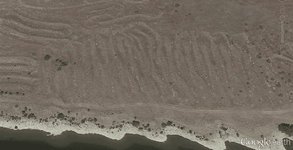OwenT
Hero Member
First thing I thought when I saw this on the Columbia River was dredge tailing, but it's actually more of a snaking pattern than the stacked arcs a dredge would make. This area on the river did produce gold.

Note to anyone beginning to read this thread: It was determined that the picture shows the remnants of some sort of gold mining operation. The thread then turns a little off track and there is a debate for several pages. Finally we discuss land status and I try to find out who owns this property.

Note to anyone beginning to read this thread: It was determined that the picture shows the remnants of some sort of gold mining operation. The thread then turns a little off track and there is a debate for several pages. Finally we discuss land status and I try to find out who owns this property.
Amazon Forum Fav 👍
Last edited:
Upvote
0





 ....and knew it wasn't blm land...cool you have access within river boundary ...If they get don't get back to you after reaching out? I don't know what you could/should do.
....and knew it wasn't blm land...cool you have access within river boundary ...If they get don't get back to you after reaching out? I don't know what you could/should do.


